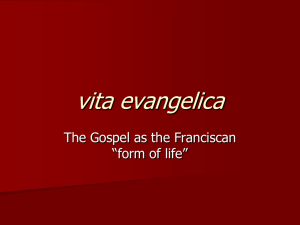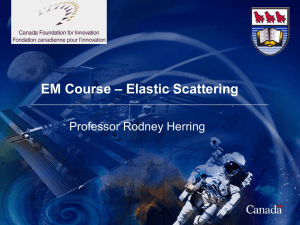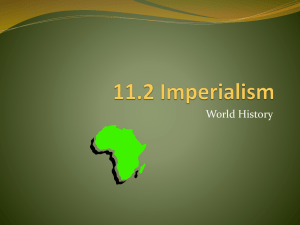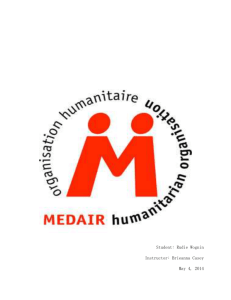Document
advertisement
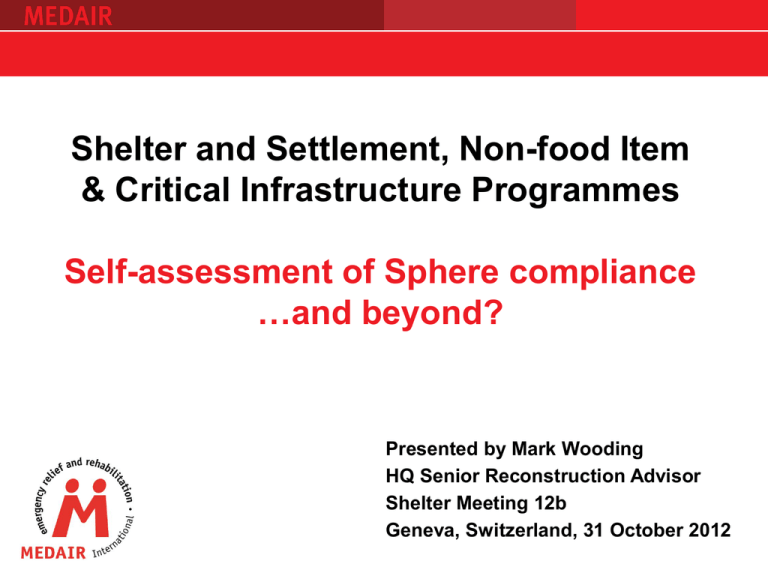
Shelter and Settlement, Non-food Item & Critical Infrastructure Programmes Self-assessment of Sphere compliance …and beyond? Presented by Mark Wooding HQ Senior Reconstruction Advisor Shelter Meeting 12b Geneva, Switzerland, 31 October 2012 Purpose of self assessment tool What? A tool comprising a single Excel form to enable Medair project managers in the field to self-assess the compliance to Sphere standards of their shelter and settlement/ non-food item/ critical infrastructure projects in emergency relief and/ or rehabilitation. How often? To be filled in initially to establish a baseline, then every quarter for all current project locations in every Medair country progranmme, and sent to the reconstruction adviser at Medair HQ in Switzerland to track progress in overall and specific compliance to Sphere. Why? To raise awareness of Sphere 2011 in the field and contribute to improving project quality through ‘soft’ performance measurement. Sections 1-3 Key data and Instructions on completing form 1. Project information Country/ Project/ Location/ Year/ Quarter 2. Person completing this assessment Full name/ email address/ Position/ Date completed 3. Instructions This spreadsheet forms part of an internal Medair monitoring system. It is not considered as, or intended to be, definitive but is to help recognise progress and also identify any gaps, hopefully highlighting areas for potential improvement in either project design or implementation. The Sphere indicators for shelter and settlements (S&S) and non-food items (NFIs) are listed below, together with similar (but non-Sphere) indicators for critical infrastructure. Relevant pages from the Sphere handbook 2011 are also listed, where additional information/ explanatory notes can be found. Instructions on completing form cont. a) Please give a score between 0-100% for this S&S/ NFI and/ or infrastructure project in this location for this quarter (three months), by estimating the percentage achievement of this indicator over the quarter. If the project supports more than one S&S/ NFI/ infrastructure site etc. the score should represent the average across all structures/ sites. 0% = Indicator never achieved this quarter 100% = Indicator always achieved this quarter b) If you feel that the Sphere indicator does not apply to your project this quarter please score "N" and use the comment box under the section to explain why the Sphere standard does not apply to your project. But note that, in general, if the Sphere standard is relevant to your project, all indicators should apply. c) Please add any comments about the achievement of the indicators in the comments section below each group of indicators, especially if the score is low. Section 4A Shelter and Settlement extract A. Shelter and Settlement Definition: Private dwellings, either individual houses or communal apartments: ‘Adequate shelter is a habitable covered living space providing a secure, healthy living environment with privacy and dignity for the groups, families and individuals within them.’ (from DFID, ‘Shelter after disaster’, p321) Standard 1: Strategic planning (see Sphere 2011 pages 250-254) Score 0-100 Sphere indicators 1.1 Shelter and settlement solutions to meet the essential needs of all the disaster-• affected population are agreed with the population themselves and relevant authorities in coordination with all responding agencies. 1.2 All temporary shelter and settlement solutions are safe and adequate and • will remain so until more durable solutions are achieved. Comments and Explanations Section 4B Non-food Items extract B. Non-food items: clothing, bedding and household items Definition: Items distributed other than food, such as clothing, household goods; but not hygiene kits, medicines etc: ‘...the basic goods and supplies required to enable families to meet personal hygiene needs, prepare and eat food, provide thermal comfort and build, maintain or repair shelters.’ (Adapted from Sphere Project, quoted in DFID, ‘Shelter after disaster’, p315) Standard 1: Individual, general household and shelter support items (see Sphere 2011 pages 269-271) Score Sphere indicators 0-100 1.1 The assessed non-food item needs of the entire disaster-affected population •• have been met. Comments and Explanations Section 4C Critical Infrastructure C. Critical infrastructure Working Definition: Essential infrastructure required to maintain critical services: Institutional buildings (for administration, education, health etc.), transport infrastructure (e.g. roads and bridges), major WASH construction (canals, dams, large water tanks etc.). Standard 1: Strategic planning (not in Sphere handbook) Sphere indicators 1.1 All critical infrastructure projects are fit for their purpose, meet the essential needs of all the disaster-affected population and are agreed with the affected population themselves and relevant authorities in coordination with all responding agencies. Comments and Explanations Score 0-100 Section 4C Critical Infrastructure cont. Standard 2: Location planning (not in Sphere handbook) Indicators 2.1 Through agreed planning processes, relevant authorities and assisted populations are consulted on and approve and/ or agree to the location of the critical infrastructure project/ access to essential services. Standard 3: Specification and contract management (not in Sphere) 3.1 All critical infrastructure designs and materials meet agreed national/ international technical and performance standards (including appropriate disaster risk reduction measures); are approved by relevant authorities; and are culturally acceptable. 3.2 All critical infrastructure projects have relevant project design documentation (plans/ BoQ/ specification), and are completed under signed contracts with the project client/ sponsor and any contractors/ subcontractors. 3.3 Handover/ maintenance documents are in place and signed off, and demonstrate that risks and vulnerabilities in the use of critical infrastructure projects and essential services have been identified and mitigated. Section 4C Critical Infrastructure cont. Standard 4: Construction (not in Sphere handbook) Indicators 4.1 All construction is in accordance with agreed safe building practices and complies with local labour laws. 4.2 Construction activities demonstrate the involvement of the affected population (using signed MoUs/ individual agreements) and the maximising of local livelihood opportunities. Standard 5: Environmental impact (not in Sphere handbook) Indicators 5.1 The planning of all critical infrastructure projects demonstrates that adverse impact on the natural environment has been minimised and/ or mitigated. 5.2 The construction processes and sourcing of materials for all critical infrastructure projects demonstrate that adverse impact on the local natural environment has been minimised and/ or mitigated. Section 5 Automated Analysis 5. Automated analysis Estimated Sphere compliance for this project this quarter Number of Sphere indicators applicable during this quarter (Q) Number of applicable Sphere indicators always achieved (100%) this Q Percentage full compliance with applicable Sphere indicators this Q Average percentage compliance with applicable Sphere indicators this Q (End) NOTE: Various ‘pop-ups’ appear if cells are incorrectly completed to assist with entering valid responses (150% for example!) Beyond Sphere…? Medair is seeking to develop a programme performance dashboard/ ‘balanced scorecard’ within each of its core sectors (Health & Nutrition/ Shelter & Infrastructure/ WaSH), that will allow effective but minimally disruptive oversight and simplify decision-making. Sphere standards can be viewed as a useful minimum benchmark for programme quality, but for shelter and settlement these indicators alone are not sufficiently SMART. Currently, a framework is being explored using a combination of Groupe URD’s Quality COMPAS, DAC criteria and others to identify the 10-12 most critical quality indicators (existing and/ or new and including Sphere compliance) that in combination are SMART and can give meaningful direction; e.g. construction risk assessment tool If your organisation is there already, we’d like to hear from you..! Any questions or feedback? mark.wooding@medair.org


